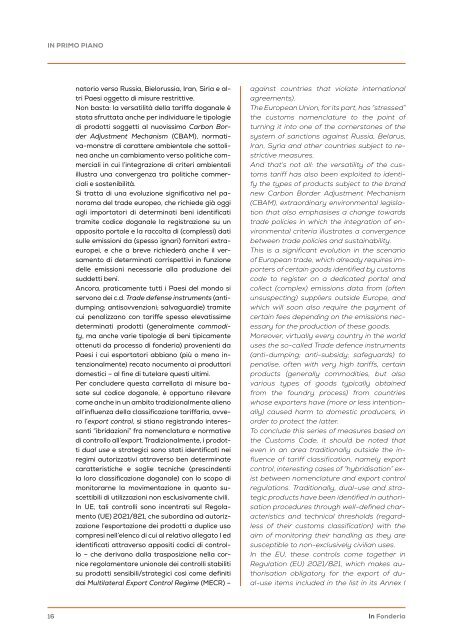In Fonderia 1 2024
Primo numero del 2024 di In Fonderia
Primo numero del 2024 di In Fonderia
You also want an ePaper? Increase the reach of your titles
YUMPU automatically turns print PDFs into web optimized ePapers that Google loves.
IN PRIMO PIANO<br />
natorio verso Russia, Bielorussia, Iran, Siria e altri<br />
Paesi oggetto di misure restrittive.<br />
Non basta: la versatilità della tariffa doganale è<br />
stata sfruttata anche per individuare le tipologie<br />
di prodotti soggetti al nuovissimo Carbon Border<br />
Adjustment Mechanism (CBAM), normativa-monstre<br />
di carattere ambientale che sottolinea<br />
anche un cambiamento verso politiche commerciali<br />
in cui l’integrazione di criteri ambientali<br />
illustra una convergenza tra politiche commerciali<br />
e sostenibilità.<br />
Si tratta di una evoluzione significativa nel panorama<br />
del trade europeo, che richiede già oggi<br />
agli importatori di determinati beni identificati<br />
tramite codice doganale la registrazione su un<br />
apposito portale e la raccolta di (complessi) dati<br />
sulle emissioni da (spesso ignari) fornitori extraeuropei,<br />
e che a breve richiederà anche il versamento<br />
di determinati corrispettivi in funzione<br />
delle emissioni necessarie alla produzione dei<br />
suddetti beni.<br />
Ancora, praticamente tutti i Paesi del mondo si<br />
servono dei c.d. Trade defense instruments (antidumping;<br />
antisovvenzioni; salvaguardie) tramite<br />
cui penalizzano con tariffe spesso elevatissime<br />
determinati prodotti (generalmente commodity,<br />
ma anche varie tipologie di beni tipicamente<br />
ottenuti da processo di fonderia) provenienti da<br />
Paesi i cui esportatori abbiano (più o meno intenzionalmente)<br />
recato nocumento ai produttori<br />
domestici – al fine di tutelare questi ultimi.<br />
Per concludere questa carrellata di misure basate<br />
sul codice doganale, è opportuno rilevare<br />
come anche in un ambito tradizionalmente alieno<br />
all’influenza della classificazione tariffaria, ovvero<br />
l’export control, si stiano registrando interessanti<br />
“ibridazioni” fra nomenclatura e normative<br />
di controllo all’export. Tradizionalmente, i prodotti<br />
dual use e strategici sono stati identificati nei<br />
regimi autorizzativi attraverso ben determinate<br />
caratteristiche e soglie tecniche (prescindenti<br />
la loro classificazione doganale) con lo scopo di<br />
monitorarne la movimentazione in quanto suscettibili<br />
di utilizzazioni non esclusivamente civili.<br />
<strong>In</strong> UE, tali controlli sono incentrati sul Regolamento<br />
(UE) 2021/821, che subordina ad autorizzazione<br />
l’esportazione dei prodotti a duplice uso<br />
compresi nell’elenco di cui al relativo allegato I ed<br />
identificati attraverso appositi codici di controllo<br />
– che derivano dalla trasposizione nella cornice<br />
regolamentare unionale dei controlli stabiliti<br />
su prodotti sensibili/strategici così come definiti<br />
dai Multilateral Export Control Regime (MECR) –<br />
against countries that violate international<br />
agreements).<br />
The European Union, for its part, has “stressed”<br />
the customs nomenclature to the point of<br />
turning it into one of the cornerstones of the<br />
system of sanctions against Russia, Belarus,<br />
Iran, Syria and other countries subject to restrictive<br />
measures.<br />
And that’s not all: the versatility of the customs<br />
tariff has also been exploited to identify<br />
the types of products subject to the brand<br />
new Carbon Border Adjustment Mechanism<br />
(CBAM), extraordinary environmental legislation<br />
that also emphasises a change towards<br />
trade policies in which the integration of environmental<br />
criteria illustrates a convergence<br />
between trade policies and sustainability.<br />
This is a significant evolution in the scenario<br />
of European trade, which already requires importers<br />
of certain goods identified by customs<br />
code to register on a dedicated portal and<br />
collect (complex) emissions data from (often<br />
unsuspecting) suppliers outside Europe, and<br />
which will soon also require the payment of<br />
certain fees depending on the emissions necessary<br />
for the production of these goods.<br />
Moreover, virtually every country in the world<br />
uses the so-called Trade defence instruments<br />
(anti-dumping; anti-subsidy; safeguards) to<br />
penalise, often with very high tariffs, certain<br />
products (generally commodities, but also<br />
various types of goods typically obtained<br />
from the foundry process) from countries<br />
whose exporters have (more or less intentionally)<br />
caused harm to domestic producers, in<br />
order to protect the latter.<br />
To conclude this series of measures based on<br />
the Customs Code, it should be noted that<br />
even in an area traditionally outside the influence<br />
of tariff classification, namely export<br />
control, interesting cases of “hybridisation” exist<br />
between nomenclature and export control<br />
regulations. Traditionally, dual-use and strategic<br />
products have been identified in authorisation<br />
procedures through well-defined characteristics<br />
and technical thresholds (regardless<br />
of their customs classification) with the<br />
aim of monitoring their handling as they are<br />
susceptible to non-exclusively civilian uses.<br />
<strong>In</strong> the EU, these controls come together in<br />
Regulation (EU) 2021/821, which makes authorisation<br />
obligatory for the export of dual-use<br />
items included in the list in its Annex I<br />
16<br />
<strong>In</strong> <strong>Fonderia</strong>














